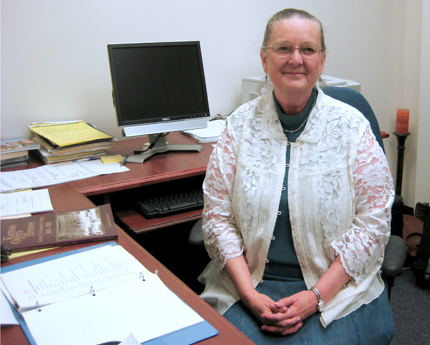A passion for theater and history drove Jane Glotfelty Rhoads to hit the Kansas highways for her recently published book “Kansas Opera Houses: Actors & Community Events 1855-1925."
The 158-page book – filled with photos, statistics and in-depth histories – has been named a 2009 Kansas Notable Book by the Kansas Center for the Book at the State Library of Kansas.
Rhoads, director of undergraduate success programs at WSU, found more than statistics about the 903 opera houses once in operation in Kansas, however. She found the former heart of many communities.
Her research took about 17 years of driving to 432 communities in Kansas. It took time spent in small and large places, reading and listening to countless stories rising from town libraries, newspapers, city and county offices, local restaurants and other businesses.
“When I began this, I was interested in the dramatic aspects of opera houses,” said Rhoads, “but the more I learned, the more I realized that the importance of the local opera house was not just as a place to see plays and later silent movies, but it was where they played basketball, held dances and graduations, had town meetings.”
Rhoads’ interests in theater and history were nurtured throughout her life.
As a little girl visiting grandparents, Rhoads was allowed to play on the abandoned opera house stage built by her great-grandfather in Eldon, Iowa, and still owned by her family. Amid scenery treasures left behind, Rhoads stretched her imagination.
“I loved it, and have always loved theater,” she said.
In fact, said Rhoads, her master’s degree is in theater; her undergraduate degree is in history.
Her father, born in 1904, helped supply her interest in history with tales of his youth in the opera house as a 5-year-old seat duster who earned promotions throughout his youth to scenery mover, ticket seller and, as silent movies came in, projectionist.
“Once my children were grown and I had time to explore,” said Rhoads, “I wondered how many opera houses still existed in Kansas.”
A trip to the State Historical Society in Topeka netted her a guide put out by the Santa Fe Railroad in 1907 to all of the opera houses on the Santa Fe from Chicago to L.A., because in those days actors traveled by rail.
“I copied the section on Kansas and set out to discover how many opera houses listed in the guide still existed. Of course, the project just grew from there.”
Union Pacific Railroad also published an opera house guide, Rhoads found, and there were also professions guides. She developed her list, read all of the city and county centennial books she could find, and finally took to the road with her husband, John, a photographer who enjoyed being along for the ride.
“I loved hearing the stories about what people remembered about their local opera houses,” Rhoads said. “The delightful thing about the process was how helpful folks were. Because opera houses were so important to rural communities, it wasn’t difficult to find folks who had attended events in them. Best remembered were always the high school graduations.
“In fact, the end of the opera house era was almost always linked to the construction to the new high school with an auditorium,” she said. “After that, the opera houses weren’t needed as a community meeting space.”
Because opera houses were important to the social and cultural development of communities, Rhoads has donated a copy of the book to each public library in the state.
A brief summary of Rhoads’ research
• Opera houses standing with a stage and in use as an entertainment venue – 16
• Standing with a stage and being renovated – 4
• Standing with a stage and in use as a community center – 18
• Standing with a stage but used for something other than entertainment – 8
• Standing with a stage but building is vacant – 8
• Total opera houses standing with stages – 54
• Standing without a stage/ building in use – 113
• Standing without a stage /building vacant – 33
• Total buildings that once contained opera house still standing – 200
• No longer standing – 541
• Unable to determine whether opera house was standing or not – 162
• Number of structures that contained opera houses – 903


 Joe Kleinsasser
Joe Kleinsasser